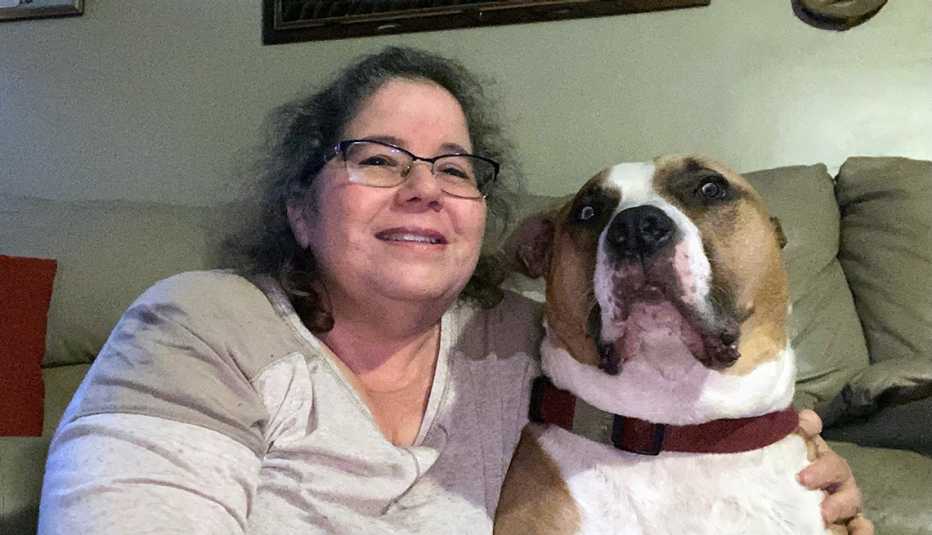Staying Fit
When Karen Hopper, 57, of Cooper City, Florida, looked into pet insurance for Rusty, her five-year-old Staffordshire terrier, it didn’t seem worth the cost.
Rusty had a knee injury from jumping off the bed when he was two years old, and the plan Hopper was offered through her job wouldn’t cover preexisting conditions. Since she’d probably be dealing with the repercussions of Rusty's torn ACL for years, why pay a monthly fee when those expenses wouldn’t be covered?


AARP Membership— $12 for your first year when you sign up for Automatic Renewal
Get instant access to members-only products and hundreds of discounts, a free second membership, and a subscription to AARP the Magazine.
But less than a year later, Hopper had to charge a $4,000 surgery to remove a piece of rubber lodged in Rusty’s abdomen on her credit card. “I was like, ‘Maybe I should’ve gotten the insurance,' ” she says.


Many dog and cat owners struggle with whether to buy pet insurance. Between coverage limitations, high deductibles, network constraints and wellness options, navigating the pet insurance industry can be as challenging as making sense of human health insurance. So is it worth it?
While Hopper and others address health issues as they arise and hope for the best, some pet owners say the monthly premiums for pet insurance actually relieve stress.
Researching Pet Insurance Policies and Plans?
If you're thinking of investing in pet insurance, here are seven things to consider.
1. Ask your breeder, rescue organization or vet if they can recommend an insurer — or consider bundling your policy with your car, homeowners or another existing policy.
2. Generally, the higher the deductible, the lower the premium. Your deductible decision should be based on how much money you could comfortably come up with in case of emergency.
3. If you’re thinking of purchasing pet insurance, it’s better to do so before your pet is diagnosed with something serious. Pre-existing conditions may not be covered.
4. Be mindful of lifetime or annual cap limits. “A cap can really get you in trouble,” says Colleen Stratton, who spent thousands on medical treatments for her cat.
5. While most plans cover dogs and cats, some plans will cover exotic pets like lizards, birds, rabbits and other creatures. Be sure to do additional research if you’re looking for coverage for those animals.
6. Wellness plans that cover vaccines, grooming and other routine services will cost more per month, but they can help owners budget month-to-month pet expenses.
7. Be sure to read the fine print so you know what a plan does and does not cover.
A growing pet insurance industry
According to the “2021 State of the Industry Report” from the North American Pet Health Insurance Association (NAPHIA), the industry is growing annually by an average of 23.4 percent. Around 3.45 million pets were insured across the United States and Canada by the end of 2020.
After Colleen Stratton’s cat Pyewackett cost her thousands of dollars — which she borrowed from her father — for a hyperthyroid treatment, she took out an insurance policy on Pyewackett as well as her second cat, Sho-Zen. “It was a godsend,” says the resident of Glendale, California, “because [Sho-Zen] started having health problems and slowly deteriorated over a period of three years.”
Her Pets Best Insurance plan, which cost $60 a month for two cats a decade ago, paid 80 percent of the bills after a $500 deductible. Now those cats are gone, and Stratton has two young healthy felines— and a premium that jumped from $87.32 to $127.68 per month this year for reasons she still does not understand. Stratton is weighing whether or not to keep the plan, increase the deductible, shop around or put that money into an emergency savings account. “I keep researching,” she says. “But there is something comforting about knowing I have pet insurance, and I’m afraid to cancel it.”
That sense of comfort is the reason many pet owners opt in.
“Pet insurance is a financial product, but it's also an emotional product,” says Kristin Lynch, executive director of the NAPHIA. “You care a lot about your pet and you want to be sure if something happens, you want to have the means to take care of them.”
What to watch out for
In the U.S., the average premium for accident and illness coverage is $49.51 per month for dogs and $28.48 for cats, according to the NAPHIA. For accident coverage only, it’s $18.17 and $11.13, respectively. Premiums fluctuate based on age, breed and where you live.




































































